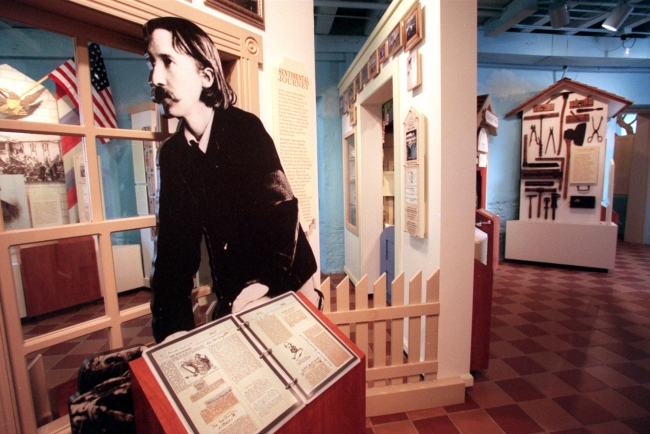 |
A cutout of Robert Louis Stevenson looks over the first floor of the Pacific House Museum in Monterey, California. (MCT) |
It’s hard to believe it’s been six years since the publication of Nancy Horan’s best-selling debut, “Loving Frank,” a riveting tale centered on Frank Lloyd Wright’s lover and muse, Mamah Borthwick Cheney, that remains vividly fresh in my memory.
In her new novel, “Under the Wide and Starry Sky,” she once again takes a deep, discerning dive into a famous man’s life by focusing on a significant love interest. Once again, I was enthralled.
Horan has been credited with inventing this popular subgenre of literary fiction; since “Loving Frank,” we’ve had “The Paris Wife” (Hemingway), the recent “Mrs. Poe” (Edgar Allan Poe) and many, many others along the same lines. But few writers are as masterful as she is at blending carefully researched history with the novelist’s art.
In the case of “Starry Sky,” which was just named as the latest pick for the Today Book Club, Horan aims her authorial laser at Scottish writer Robert Louis Stevenson and his lover and eventual wife, American Fanny Van de Grift Osbourne. As the story begins, Fanny, a married woman with three young children, is fleeing her cheating husband to study art in Europe. “It’s one of the few respectable ways a woman can leave a rotten husband,” a friend tells her. Both Fanny and her daughter are talented painters, and Fanny also aspires to a writing career.
Denied admission to their chosen school in Antwerp because they are, horrors, women, Fanny and Belle (and Fanny’s two sons) move to Paris and study art while living on bare bones. Then the youngest child, preschooler Hervey, dies of scrofulous tuberculosis. Overcome with grief and needing a cheap escape, the family moves to Grez-sur-Loing, a Bohemian riverside colony.
There Fanny meets not one but two Scots named Stevenson: Bob (Robert Louis’ cousin), introduced as wearing “trousers that ended at the knees, stockings with red and white horizontal stripes, and a smirk.” Robert Louis ― called Louis or Lou ― makes an even more remarkable entrance: Wearing a black velvet jacket, an embroidered felt smoking cap, a red sash, white linen pants and high boots, “He walked quickly to the house, pausing to consider each of the two doors. Rejecting both, he chose the open window. With the grace of a high jumper, he threw one long leg and then the other over the windowsill and hurled himself into the dining room.”
His friends call Louis the “Great Exhilarator.” Fanny, 10 years older than Louis but young in heart and mind, couldn’t help but notice.
The admiration is mutual, but their love builds slowly. Once the sparks rise to flames, Fanny divorces Evil Husband and marries Louis, who begins tinkering with “Treasure Island” when Fanny’s son Sammy asks him to “tell me a pirate story.”
The Stevensons’ way was rarely easy. Louis battled with both his writing and his health, barely escaping death from maladies related to weak lungs. Money was always a problem, even after Louis’ books began selling. Fanny suffered from bouts of what sound like migraines and bipolar disorder. She envied Louis’ literary success, and she resented his friends who, she believed (with some cause), treated her as an outsider.
Horan’s prose is gorgeous enough to keep a reader transfixed, even if the story itself weren’t so compelling. I kept rereading passages just to savor the exquisite wordplay. Even the smallest characters, including the nonhuman ones, rate full range of personality. Modestine the donkey, Louis’ companion on one of his wilderness trips, is a creature I would happily admit into my own family. Henry James and John Singer Sargent make cameo appearances. (If you want to see why Fanny felt shoved to the side, just Google Sargent’s 1885 “Robert Louis Stevenson and His Wife,” in which she is shown cloaked, at one edge of the frame).
Toward the end, as Louis struggles with what would become his masterpiece, “Strange Case of Dr. Jekyll and Mr. Hyde,” it’s intriguing to draw comparisons between his “duality of man” theme and the polarities of his and Fanny’s relationship. She had brave physicality and an oft-troubled mind; he was physically weak but always mentally acute. Together, they were brilliance personified.
By Joy Tipping
(The Dallas Morning News)
(MCT Information Services)








